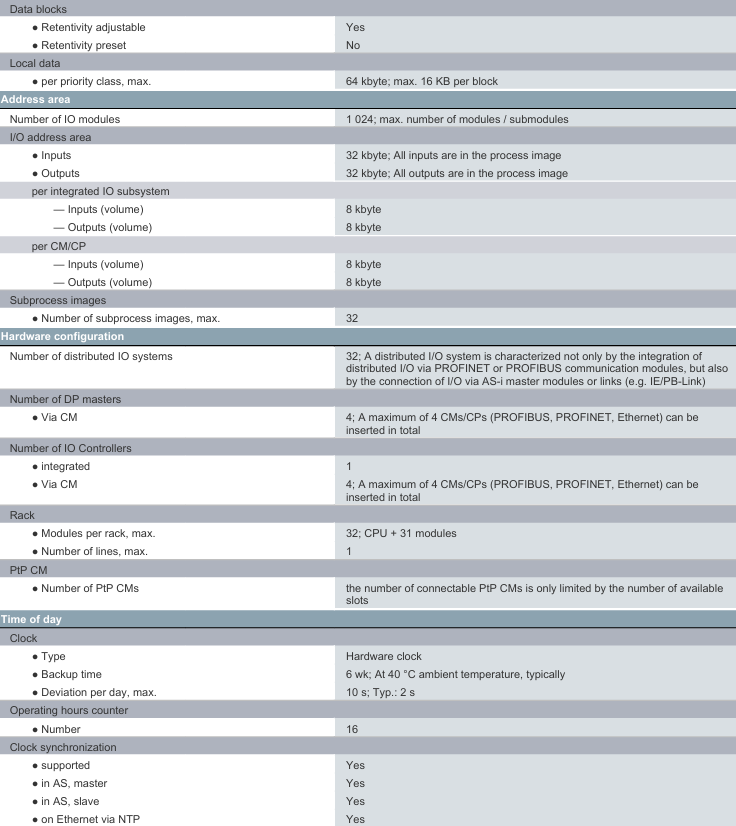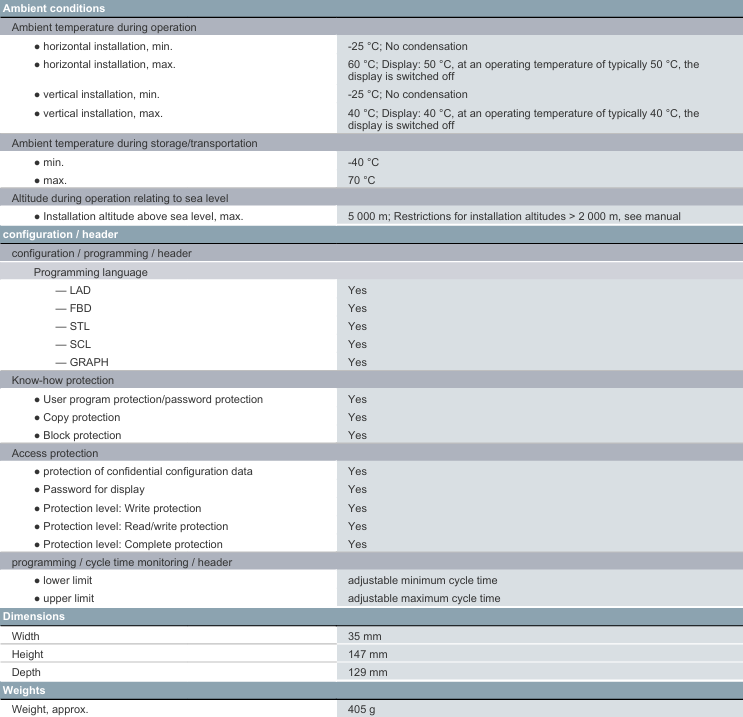Siemens 6ES7511-1AK02-0AB0 SIMATIC S7-1500 CPU 1511-1 PN Central Processing Unit
(1) Program capacity and block resources
Specific parameters of resource type
Up to 4000 data blocks (DB) (including UDT), address range 1~60999 (user available 1~59999), maximum 1 MB per DB (absolute addressing DB maximum 64 KB)
Function blocks (FB/FC) have a maximum of 65535 FB and FC respectively, with a maximum of 150 KB for a single FB/FC/OB
Organizational Block (OB) supports multiple types of OB: 100 free loop OB, 20 time alarm OB, 20 loop interrupt OB (minimum cycle 500 μ s), 50 process alarm OB, etc
(2) Task scheduling
Support priority task management (levels 0-15), with each priority class nested at a depth of 24 levels;
The isochronous mode supports both distributed and centralized modes, with a minimum OB 6x cycle of 625 μ s (distributed) and 1 ms (centralized), meeting high-precision synchronous control requirements.
2. Timers and counters
S7 timer/counter: 2048 each, supporting retention (configurable);
IEC timer/counter: unlimited quantity (limited only by memory), supports persistent configuration;
Clock memory: 8 clock memory bits (1 byte) used to generate periodic signals (such as 0.5 s, 1 s pulses).
3. Technical functions (motion, process control)
(1) Motion control
Resource support: Supports Motion Control technology objects, with a total of 800 resources allocated as follows:
Speed control axis: 40 resources/axis; Positioning axis: 80 resources/axis; Synchronization axis: 160 resources/axis;
External encoder: 80 resources per unit; Output cam: 20 resources/piece; Cam trajectory: 160 resources/piece; Probe: 40 resources/piece;
Number of axes: up to 5 positioning axes in a 4 ms motion control cycle, and up to 10 positioning axes in an 8 ms cycle.
(2) Process control
PID controller: supports PID_Compact (universal PID), PID_Step (valve specific), PID Test (temperature specific), all with integrated optimization function;
High speed counting: Supports high-speed counter function and is suitable for pulse signal acquisition (such as encoder signals).
4. Diagnosis and Debugging
Diagnostic buffer: up to 1000 records (including 500 power down hold), recording device faults, program errors, and other information;
Tracking function: up to 4 configurable traces, each with a maximum of 512 KB of data, used to record variable changes and program execution trajectories;
Online debugging: Supports Team Engineering (up to 5 engineering systems can be accessed online in parallel), up to 8 breakpoints, variable status monitoring and forcing (up to 200 peripheral I/O variables).

Environmental adaptability and certification
1. Environmental parameters
Specific indicators of environmental parameters
Working temperature - horizontal installation: -25 ℃~60 ℃ (the display screen automatically turns off when it reaches 50 ℃)
-Vertical installation: -25 ℃~40 ℃ (display screen automatically shuts off at 40 ℃)
Storage/transportation temperature -40 ℃~70 ℃ (non condensing)
Relative humidity 5%~95% RH (non condensing)
The maximum installation altitude is 5000 meters (when the altitude is>2000 meters, please refer to the manual for restrictions)
The anti vibration performance meets the IEC 60068-2-6 standard, with a maximum acceleration of 5 m/s ² at frequencies ranging from 10 to 500 Hz
The impact resistance performance meets the IEC 60068-2-27 standard, with a continuous duration of 11 ms at an acceleration of 15 g
2. Compliance certification
Safety certification: UL 508, CSA C22.2 No. 142, EN 61131-2;
Electromagnetic compatibility (EMC): EN 61000-6-2 (anti-interference in industrial environments), EN 61000-6-4 (emission in industrial environments);
Hazardous environment certification: Supports EX Zone 2/22 (requires corresponding module coordination);
Regional compliance: CE mark, in compliance with EU market access requirements.
Programming and Security
1. Programming software and language
Supported software: STEP 7 TIA Portal V15 (firmware V2.5) and above, V17 supports firmware V2.9; The old version of TIA Portal is compatible with configuration 6ES7511-1AK01-0AB0;
Programming language: Supports ladder diagrams (LAD), function block diagrams (FBD), statement tables (STL), structured text (SCL), and sequential function diagrams (GRAPH) to meet different programming habits.
2. Security protection
Program protection: supports user password protection, block protection, and copy protection (Know how protection) to prevent unauthorized modification and copying;
Data Security: Confidential configuration data protection, display password protection, support three-level access permissions (write protection, read/write protection, full protection);
Communication encryption: PG/OP communication, web servers, S7 communication support TLS V1.3 encryption, OPC UA supports multiple security policies (such as Basic256Sha256).

- EMERSON
- Honeywell
- CTI
- Rolls-Royce
- General Electric
- Woodward
- Yaskawa
- xYCOM
- Motorola
- Siemens
- Rockwell
- ABB
- B&R
- HIMA
- Construction site
- electricity
- Automobile market
- PLC
- DCS
- Motor drivers
- VSD
- Implications
- cement
- CO2
- CEM
- methane
- Artificial intelligence
- Titanic
- Solar energy
- Hydrogen fuel cell
- Hydrogen and fuel cells
- Hydrogen and oxygen fuel cells
- tyre
- Chemical fiber
- dynamo
- corpuscle
- Pulp and paper
- printing
- fossil
- FANUC
- Food and beverage
- Life science
- Sewage treatment
- Personal care
- electricity
- boats
- infrastructure
- Automobile industry
- metallurgy
- Nuclear power generation
- Geothermal power generation
- Water and wastewater
- Infrastructure construction
- Mine hazard
- steel
- papermaking
- Natural gas industry
- Infrastructure construction
- Power and energy
- Rubber and plastic
- Renewable energy
- pharmacy
- mining
- Plastic industry
- Schneider
- Kongsberg
- NI
- Wind energy
- International petroleum
- International new energy network
- gas
- WATLOW
- ProSoft
- SEW
- wind
- ADVANCED
- Reliance
- YOKOGAWA
- TRICONEX
- FOXBORO
- METSO
- MAN
- Advantest
- ADVANCED
- ALSTOM
- Control Wave
- AB
- AMAT
- STUDER
- KONGSBERG
- MOTOROLA
- DANAHER MOTION
- Bently
- Galil
- EATON
- MOLEX
- Triconex
- DEIF
- B&W
- ZYGO
- Aerotech
- DANFOSS
- KOLLMORGEN
- Beijer
- Endress+Hauser
- MOOG
- KB
- Moxa


Email:wang@kongjiangauto.com






















































































